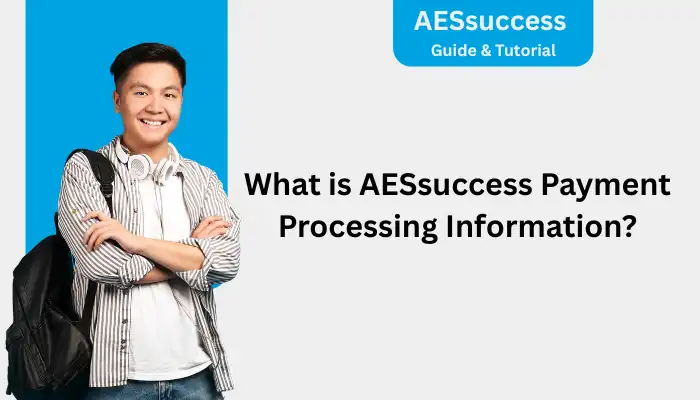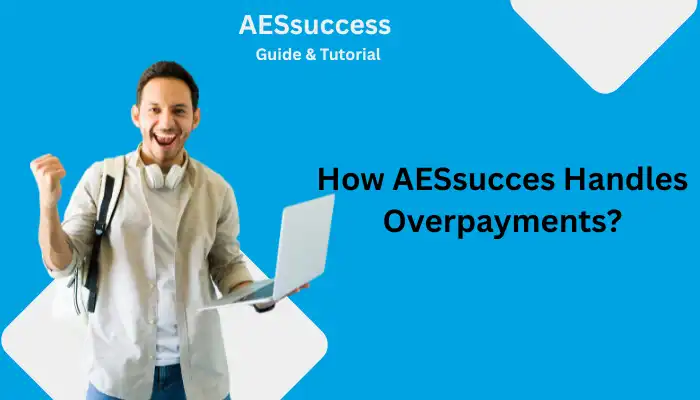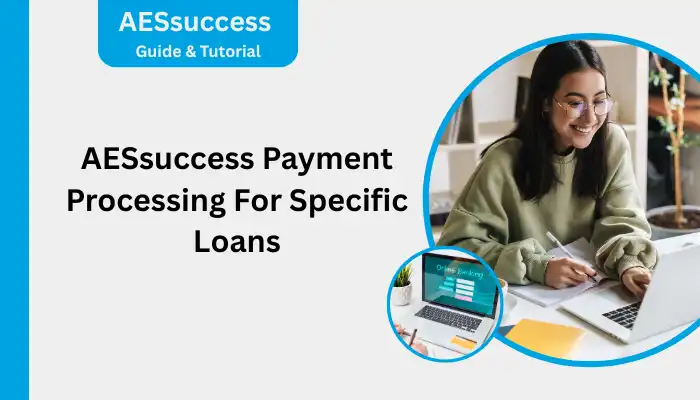Dealing with student loan AESsuccess payments can feel like navigating a maze blindfolded, but with AESsuccess payment processing, you can take control and make smart choices.

I’m here to walk you through AESsuccess payment processing Information, and I will even show you how to set it up using the AESsuccess login.
My goal is to help you use this platform to save money, avoid pitfalls, and pay off your loans like a pro. Let’s dive into the details!

What is AESsuccess Payment Processing Information?
Let’s dive into AESsuccess payment processing—it’s the blueprint for how your student loan payments are handled and applied. When I started paying off my loans, I assumed my payments would automatically chip away at my highest balance. Spoiler: 1000% WRONG! Understanding payment processing is your ticket to saving money and avoiding frustration.
I’m here to guide you through it like a trusted colleague, with a friendly, expert vibe and a sprinkle of humor. With AESsuccess payment processing, you can control how extra payments are applied and know exactly when payments are processed.
Here’s what you need to know to use this system like a pro:
- Payment Allocation: It’s all about how your payments are distributed across your loans, whether you’re paying the exact amount, extra, or less than the Total Due.
- Flexibility: You can direct overpayments to specific loans (like those with the highest interest rate) or set rules for underpayments to minimize delinquency.
- Transparency: Use Account Access to see how payments are split between accrued interest, late fees, and principal balance, helping you plan smarter.
- Control: Tools like Standing Payment Instructions and Direct Debit let you customize how payments are applied, saving time and interest costs.
This is a cool tip: mastering payment processing lets you take charge of your loans, whether you’re crushing AESsuccess rate with overpayments or managing tight months with underpayments. Ready to explore the details? Let’s keep going!
How Are Payments Distributed In AESsuccess?
Let’s start with the foundation: payment application is how your payments are distributed across your loans. Whether you’re paying the exact amount, extra, or less than the Total Due, AES has a system.
When I first started, I didn’t realize how much daily interest accrual affected my payments—big mistake! Here’s how it works:
- Payments typically go to accrued interest first, then late fees (if applicable), and finally the current principal balance.
- Some loans prioritize late fees, then accrued interest, then principal balance.
- Since interest accrues daily, the longer the gap since your last payment, the more goes to interest instead of principal.
To check your specific payment application order, sign into Account Access and visit the Loan Details section.
Want to review a past payment? Go to the Payment and Billing tab, select Payment History, choose a payment, and click View Details to see how it split between interest and principal. This is a cool tip: knowing this breakdown helps you plan smarter payments.
How To Check Payment Application?
- Sign into Account Access.
- Go to Loan Details to see your loan’s payment order.
- Navigate to Payment and Billing > Payment History.
- Select a payment and click View Details to view interest vs. principal allocation.
Understanding payment application lets you see how daily interest accrual impacts your loans, so you can time payments to reduce interest costs.

How AESsucces Handles Overpayments?
Paying more than the Total Due (minus late fees) is a game-changer. I started tossing an extra $75 at my loans each month, and it felt amazing to see my interest costs drop over time.
Overpayments reduce your principal balance faster, saving you money long-term. But without instructions, AES follows a specific process:
- Overpayments go to the loan with the highest interest rate, even if you’re on Income-Based Repayment with a $0 payment.
- If multiple loans have the highest interest rate, unsubsidized or private loans get priority.
- If multiple unsubsidized or private loans share the same rate, the payment is split proportionally based on loan balance.
- No unsubsidized loans? The payment goes to subsidized loans with the highest interest rate, prorated by loan balance.
- KeyBank borrowers on a Keys 2 Repay plan? Your overpayment is prorated across loans based on the total balance (including fees, interest, and principal).
If you still can’t understand, check out AES’s payment processing examples for overpayments to see this in action.
| Scenario | Loan Details | Overpayment Allocation |
|---|---|---|
| Multiple Loans, Same Rate | Loan A: 6.8%, $12,000 (unsubsidized) Loan B: 6.8%, $6,000 (unsubsidized) | $600 overpayment splits: $400 to Loan A, $200 to Loan B (proportional to loan balance) |
| Mixed Loan Types | Loan A: 6.8%, $10,000 (unsubsidized) Loan B: 4.5%, $8,000 (subsidized) | $500 overpayment goes entirely to Loan A (prioritizes unsubsidized loan with highest interest rate) |
I once skipped giving instructions, and my extra payment went to a low-interest loan I wasn’t targeting—super annoying! Always specify your allocation via Account Access or the mobile app.
How Underpayments Are Processed in AESsuccess?
Underpayments—paying less than the Total Due (minus late fees)—happen, and I’ve been there during lean months. AESsuccess payment processing aims to minimize delinquency and prevent default. Without instructions,
here’s how underpayments are allocated:
- Payments go to the most delinquent loans first to reduce the risk of default.
- If loans are equally delinquent, priority goes to loans facing credit reporting soonest, then those with late fees, then by lowest amount due to highest.
- If amounts due are equal, allocation favors:
- Highest interest rate
- Unsubsidized or private loans
- Highest balance
- Oldest first disbursement date
- Payments are prorated across matching loans.
- No unsubsidized loans? The same logic applies to subsidized loans.
Review payment processing examples for underpayments for clarity.
| Scenario | Loan Details | Underpayment Allocation |
|---|---|---|
| Equal Delinquency | Loan A: $100 due, 6.5% interest Loan B: $100 due, 4.5% interest | $150 payment: $100 to Loan A (pays in full, highest interest rate), $50 to Loan B |
| Different Delinquency | Loan A: 45 days past due Loan B: 15 days past due | $100 payment goes entirely to Loan A (most delinquent) |
Underpayments keep your account past due, but partial payments can reduce delinquency levels, helping avoid credit reporting or default. I once made a partial payment and called AES—they helped me figure out options to stay on track. If you can’t afford a payment or are already past due, contact AES for help.

AES Success Payment Processing For Specific Loans
Want to target a specific loan, like the one with the highest interest rate? You’re in control! I love this feature—it’s like choosing which villain to defeat first. The easiest way is through Account Access or the mobile app.
If you’re on Direct Debit, you can specify additional amounts for individual loans and adjust anytime via Account Access. For ongoing control, set up Standing Payment Instructions to dictate how future over- or underpayments are applied.
Here’s how to do it:
- Online/Mobile: Select specific loans when making a payment.
- Direct Debit: Update allocations in Account Access.
- By Mail: Include separate instructions (see below).
- Phone: Call AES for guided assistance.
I used to allocate payments manually each month, which worked well… for a while. Then I set up Standing Payment Instructions and saved myself the hassle. Trust me, automate where you can!
How To Set Up Standing Payment Instructions?
Standing Payment Instructions are your secret weapon for consistent allocation, whether you’re overpaying or underpaying. They apply to all future payments unless you provide alternate instructions for a specific payment. Here’s the breakdown:
Standing Overpayment Instructions:
- Choose options like highest interest rate or a custom percentage to specific loans.
- If a loan no longer matches (e.g., you pay off all unsubsidized loans), AES shifts to subsidized loans with similar criteria.
- If you set a percentage and pay off a loan, the allocation recalculates across remaining loans.
Standing Underpayment Instructions:
- Payments first satisfy outstanding bills in full, then follow your instructions.
- But here’s the catch: AES prioritizes credit reporting over your preferences, which can affect your strategy. I learned this when my underpayment went to a loan I didn’t prioritize—not ideal!
I set my overpayments to target my highest interest rate loan, and it was like finding extra cash in my budget when I saw the interest savings. Be mindful with underpayment instructions, as credit reporting priority can override your plans. Check Standing Payment Instruction Options on the AES website for all possibilities.
Providing Payment Instructions
AES offers multiple ways to provide payment instructions, which is awesome for flexibility. Here’s how to do it:
- Standing Instructions: Set up via Account Access or the back of your bill stub (for check payments).
- One-Time Instructions: Use the web, mobile app, phone, or include with check payments (but don’t write on the check!).
- Email: Use the Contact Us link in Account Access for secure messaging.
- Mail: Send to American Education Services, P.O. Box 2461, Harrisburg, PA 17105-2461. Send instructions separately from payments to avoid errors.
- Fax: Send to 717-720-3916.
What to Include:
- Your account number.
- Loan details (e.g., disbursement date, loan type) from Account Access or your bill.
- Specific allocation details. Unclear instructions? AES will contact you, but they can’t modify payment application rules tied to your loan agreement or repayment plan.
I once wrote instructions on a check, and it caused a delay—lesson learned! Keep instructions separate and clear. If you need help, AES’s phone support is super helpful.
Regret how a payment was allocated? You can request changes by contacting AES. I did this when I accidentally overpaid a low-interest loan, and they sorted it out after a quick call. Provide your account number and details of the payment you want adjusted. It’s not instant, but it’s doable.
Conclusion
Mastering AESsuccess payment processing is like learning to ride a bike—wobbly at first, but soon you’re zooming. By understanding payment application, leveraging overpayments, managing underpayments, and using Standing Payment Instructions, you can take charge of your loans.
Log into Account Access, explore payment processing examples, and don’t hesitate to contact AES if you’re stuck. You’ve got the tools to conquer your loans, and I’m rooting for you to pay them off like a champ!
